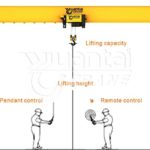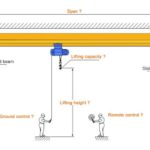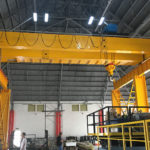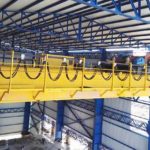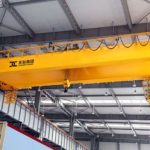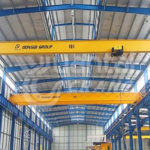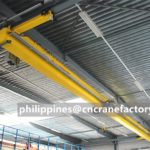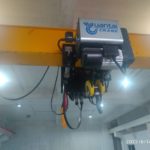When budgeting for an overhead crane for your business, you may wonder what costs lay ahead of you. However, if you’re ready to outfit your facility with a crane or cranes, then you may have already assessed the return on investment for such a purchase. Overhead cranes can increase efficiency, productivity, and worker safety in your production process, and any business owner will tell you that’s worth a lot! An overhead bridge crane is a massive piece of mechanical equipment, so you might guess that materials would significantly contribute to cost. But what other variables might be involved in affecting your crane company’s pricing, and what are you getting for your money?
What Type of Crane Do You Need?
When budgeting for an overhead crane for your business, you may wonder what costs lay ahead of you. However, if you’re ready to outfit your facility with a crane or cranes, then you may have already assessed the return on investment for such a purchase. Overhead cranes can increase efficiency, productivity, and worker safety in your production process, and any business owner will tell you that’s worth a lot! An overhead bridge crane is a massive piece of mechanical equipment, so you might guess that materials would significantly contribute to cost. But what other variables might be involved in affecting your crane company’s pricing, and what are you getting for your money?
What Type of Crane Do You Need?
There are several different types of cranes, each suited to a particular application. For example, suppose a jib crane, gantry crane, or free-standing workstation crane works for your needs. In that case, those simpler and relatively more compact lifting systems may cost substantially less than a double girder overhead bridge crane used for moving significantly larger loads farther. This would be due to the increased complexity of the engineering for a bridge crane, more materials to build it, and the additional components.
The Span of Crane
The span of a bridge crane is the length between its runway tracks, in other words, the length of the crane. The longer the crane, the greater the need for additional engineering requirements and the more steel used to build bigger crane girders. The price of steel can also fluctuate due to market value in the world economy, and the final cost of your overhead crane will be dependent on this factor. For this reason, a double girder crane will be more expensive than a single girder bridge crane.
The Runway of Crane
Do you plan on saving money by installing a new crane onto an existing runway in your workspace? If so, you must be sure that the old structure can support the weight and loading of the new crane, and if not, modifications may be needed, which could incur more expense. How long of a distance will your crane travel along the runway? The longer the runway, the more lifts your crane can make per hour, but it also requires more materials to build it. If a new runway system is required, is the existing floor able to support the crane’s load, and will the runway tie back to the building? For example, an engineering consultation might reveal that you need support columns or footer and tie-back requirements to stabilize your building/structure enough to handle the imposed loads of a system that may sway back and forth. Any type of existing obstructions, other machinery, or overhead impediments in your workspace that should be considered when installing the runway or crane may add additional costs as well.
Operating Speed
If material processing requires your crane to make fast and frequent lifts per hour, this may create stress and wear on your components. Therefore, parts will likely need to be replaced sooner than and more often than a slower moving crane. In addition, cost adders are typical for high operating speeds due to the increased horsepower required.
Capacity of Crane
Is your crane lifting 5 tons of materials at a time or upwards of 150 tons? Are you using any below-the-hook devices? The maximum load your crane can lift can make a difference in its total cost. Cranes built to withstand larger capacity loads will require the energy, engineering, materials and components to support excessive weights. At the same time, lighter lifts can be accomplished using much less from smaller and less expensive types of cranes such as workstation cranes.
Duty Cycle
Expect to pay more for larger, heavy-duty process cranes that require robust components, use of more raw materials to build and special engineering to withstand incredibly taxing conditions.
Explosion-Proof Cranes
Additionally, explosion-proof cranes in high-hazard environments may also bite into your budget. Do you work with flammable, toxic vapors or gasses, combustible metal, carbon or grain dust? There may be concentrations of hazardous substances in the air of your crane’s working environment or materials that are handled or processed in your facility. If so, an engineer will determine your crane’s Explosion Proof Classification and what type of Spark Resistance components and features or safety limits your crane will need to prevent fires or explosions on the worksite.
Transportation
How far away from your facility is located from the source of your manufactured final product, oil prices and cargos costs and taxes will also affect overhead crane affordability.
Crane Controls
What method will your crane operator use to move and load materials with your crane? On the higher end, some larger, heavy-duty bridge cranes may have a built-in cab as a control center for your operator to maneuver close to the equipment, allowing real-time monitoring of the crane’s operations. Hand-held devices are significantly less expensive. Radio controls for ground-level free-roaming operations or pendant controls that hang directly from the hoist can be purchased at affordable prices and custom configured for versatility.
Maintenance & Inspection Costs
Don’t forget about adding the cost of a proper maintenance and inspection program into your overall ongoing budget. Overhead bridge cranes are required to have OSHA mandated periodic inspection and preventative programs based on the OEM recommendations. However, the intervals are dependent on the duty cycle, typically ranging from one to four times a year performed by a qualified technician. When you are ready to make a purchase, there will be plenty of opportunities to discuss all aspects of your crane’s specific application thoroughly to make sure you get the perfect solution at the most economical price. If you have any questions, I can help you walk through about your crane.
